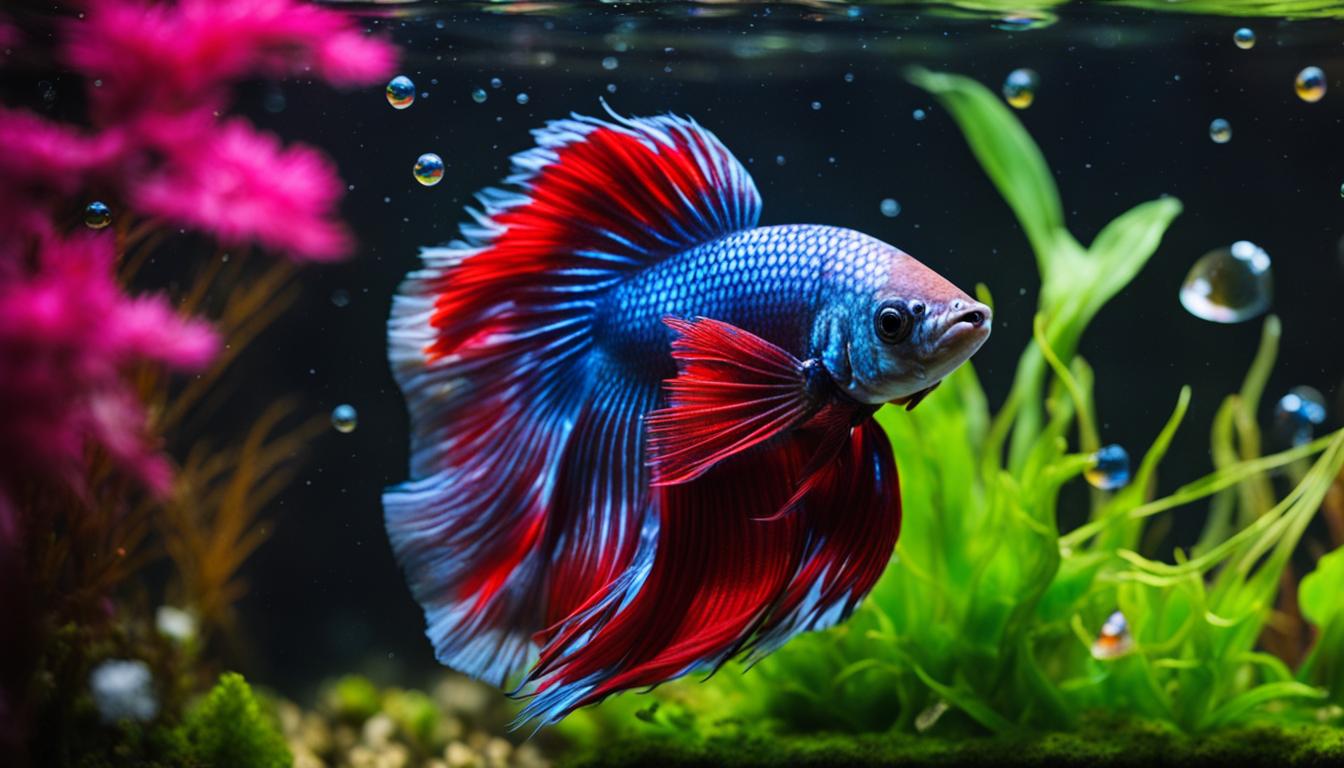Last Updated on 4 months by admin
If you’re a betta fish owner, you may have experienced the discomfort of swim bladder problems in your fish. Although it can be a common occurrence in bettas, it can also be a sign of a more serious condition. In this guide, we’ll provide you with the necessary information to effectively treat swim bladder issues in your betta fish.
From understanding what swim bladder disease is to identifying the symptoms and treatment options, we’ll cover everything you need to know to provide your fish with the best care possible. With the right knowledge and care, you can ensure your betta fish has a comfortable and healthy life.
Key Takeaways:
- Swim bladder problems are common among betta fish.
- Diet and environment play a crucial role in managing swim bladder issues.
- Natural remedies and treatment methods can assist in recovery.
- Seek professional help if swim bladder problems persist.
- Prevention is key to maintaining the health of your betta fish.
Understanding Swim Bladder Disease in Betta Fish
Swim bladder disease is a common ailment that affects betta fish. Also known as swim bladder disorder, this condition occurs when the swim bladder becomes compromised, preventing the fish from maintaining proper buoyancy and balance in the water. The swim bladder is a gas-filled organ that helps control the fish’s position in the water, allowing them to swim at different depths and angles.
There are various causes of swim bladder disease in betta fish, including genetics, bacterial infections, overfeeding, constipation, and poor water conditions. Symptoms can range from mild to severe and may include difficulty swimming, floating uncontrollably, sinking to the bottom of the tank, and a lack of appetite.
There are several potential cures for swim bladder disease in betta fish, although they depend on the severity and underlying cause of the condition. Treatment options may include medication, dietary adjustments, water changes, and natural remedies.
Now that we understand the basics of swim bladder disease, let’s take a closer look at how to identify the symptoms and potential remedies for this common ailment in betta fish.
Causes of Swim Bladder Disease in Betta Fish
The exact cause of swim bladder disease in betta fish is often difficult to pinpoint, as it can result from a variety of factors. Some of the most common causes include:
| Cause | Description |
|---|---|
| Genetics | Betta fish bred for certain physical traits may be more susceptible to swim bladder disease. |
| Bacterial Infections | Infections caused by bacteria, such as Aeromonas or Pseudomonas, can inflame the swim bladder and cause swim bladder issues. |
| Overfeeding | Overfeeding can cause bloating and constipation, leading to swim bladder issues. |
| Constipation | Constipation can be caused by overfeeding or a diet lacking in fiber, leading to swim bladder problems. |
| Poor Water Conditions | Dirty or unfiltered water can lead to bacterial infections and inflammation of the swim bladder. |
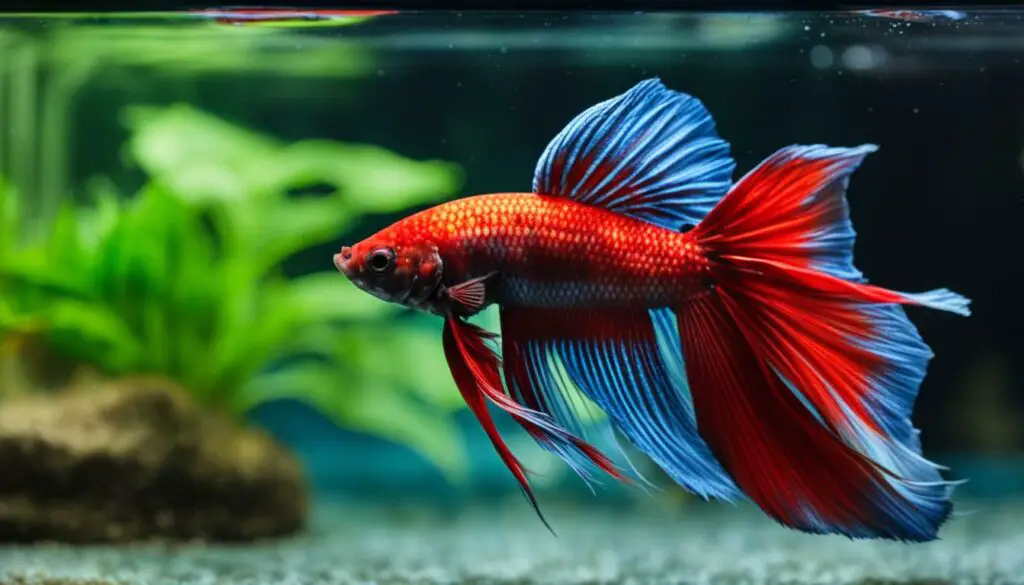
By understanding the potential causes of swim bladder disease in betta fish, we can take steps to prevent and treat this condition. In the next section, we’ll discuss how to identify the symptoms of swim bladder issues in betta fish.
Identifying Swim Bladder Problems in Betta Fish
If you notice your betta fish is having difficulty swimming or maintaining balance, it could be a sign of swim bladder problems. Other symptoms to look out for include a bloated or swollen belly, lack of appetite, and lethargy. If you suspect swim bladder issues, it’s important to address the problem promptly to prevent further discomfort or complications.
Before deciding on a course of treatment, it’s important to determine the root cause of your betta fish’s swim bladder problems. In some cases, constipation or overfeeding may be to blame. However, swim bladder issues can also be caused by bacterial infections, parasites, or physical injuries.
To identify the issue, you can observe your fish’s behavior and appearance. Look for any signs of distress or discomfort, and inspect their belly and swim bladder area for any swelling or abnormalities. If you’re uncertain about the cause or severity of your betta fish’s swim bladder issues, it’s always best to seek professional help or medication.
Identifying Swim Bladder Problems in Betta Fish Table
| Symptoms | Causes | Treatment Options |
|---|---|---|
| Bloating or swelling in the belly area | Constipation or overfeeding; bacterial infections, parasites, or physical injuries; | Adjusting diet and feeding practices; natural remedies and treatment methods; seeking veterinary assistance; |
| Difficulty swimming or maintaining balance | ||
| Lethargy and lack of appetite |
There are various remedies and treatment options available for betta fish swim bladder problems, ranging from natural remedies and medication to adjustments in diet and feeding practices. However, the key to effective treatment is early detection and prompt action. By identifying the symptoms and causes of swim bladder issues in your betta fish, you can provide them with the care and relief they need to live a healthy and happy life.

Adjusting Diet and Feeding Habits
If your betta fish is experiencing swim bladder problems, adjusting its diet can significantly help. Betta fish are primarily carnivorous, and it’s essential to provide them with a protein-rich diet.
However, feeding your fish too much or with food that’s too big can also contribute to swim bladder issues. Overfeeding leads to constipation, which can put pressure on the swim bladder, causing discomfort to your fish.
It’s best to feed your betta fish in small portions, two to three times a day. Opt for high-quality betta fish pellets that are specifically designed for their needs. You can also supplement their diet with live or frozen foods like brine shrimp or bloodworms.
| Dos | Don’ts |
|---|---|
| Feed your betta fish small portions, two to three times a day | Feed your fish too much, causing constipation |
| Opt for high-quality betta fish pellets | Feed your fish with food that’s too big |
| Supplement their diet with live or frozen foods like brine shrimp or bloodworms | Feed your fish with food that’s not specifically designed for their needs |
By making these feeding adjustments, you can help alleviate your betta fish’s swim bladder problems and prevent future issues from occurring.

Maintaining Optimal Water Conditions
Water quality is crucial to the overall health of betta fish, including their swim bladder. Poor water conditions can lead to stress, which can exacerbate swim bladder disorder. To maintain optimal water conditions:
- Regularly change the water in the tank. Aim for a 25% water change every week to keep the water fresh and clean.
- Monitor the temperature of the water. Betta fish thrive in water that is between 76-82°F. Use a thermometer to ensure the water is in the appropriate temperature range.
- Invest in a good filtration system. A filter will help remove waste and debris from the tank, which can impact water quality. Make sure to clean or replace the filter regularly.
If you notice any changes in the water quality or temperature, take immediate action to address the issue. Ignoring water quality problems can lead to serious health issues in betta fish.
Table: Water Quality Parameters for Betta Fish
| Parameter | Ideal Range | Maximum Range |
|---|---|---|
| pH | 7.0 | 6.5-7.5 |
| Ammonia (NH3) | 0 ppm | less than 0.5 ppm |
| Nitrite (NO2) | 0 ppm | less than 0.5 ppm |
| Nitrate (NO3) | less than 20 ppm | less than 40 ppm |
| Temperature | 76-82°F | N/A |
| Hardness (GH) | 5-20 dGH | N/A |
By ensuring that the water quality is optimal and stable, you can help your betta fish feel comfortable in their environment. This can greatly assist in reducing swim bladder disorder and promoting overall well-being.
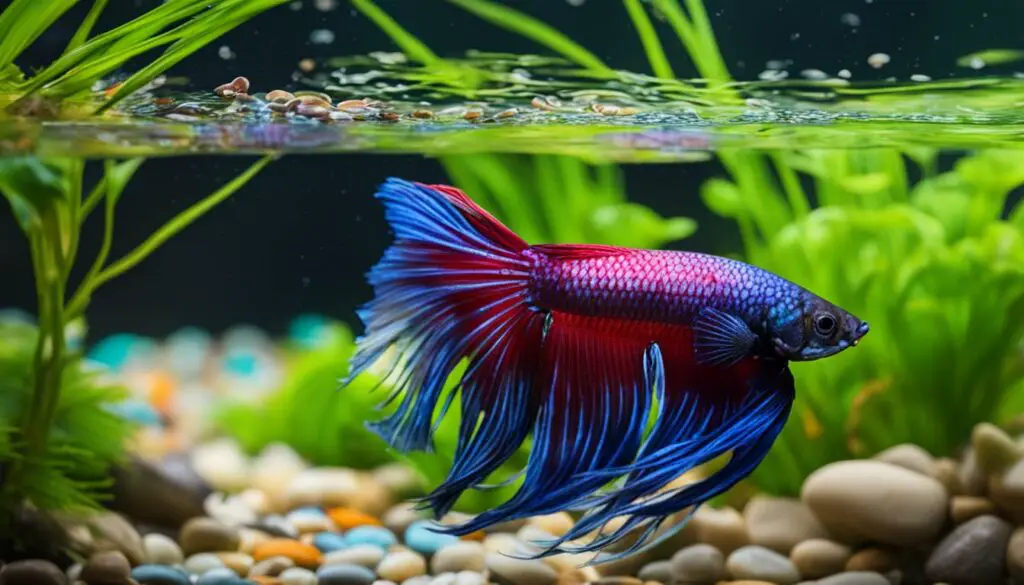
Providing Appropriate Tank Setup
If your betta fish is experiencing swim bladder problems, it’s essential to provide a comfortable and stress-free environment to alleviate their symptoms. A proper tank setup can help achieve this goal.
The first thing to consider is tank size. Betta fish need adequate space to swim and explore, so choose a tank that’s at least 5 gallons in size. Overcrowding can lead to stress, which in turn exacerbates swim bladder problems.
Filtration is another crucial factor to consider. A filter helps maintain water quality and removes harmful toxins that can affect your betta’s health. With swim bladder issues, it’s best to choose a gentle filter that won’t create strong currents. A sponge filter is an excellent option as it provides both mechanical and biological filtration without disturbing the water surface excessively.
The type of substrate you choose can also affect your betta’s comfort level. Large gravel or rocks can make it difficult for bettas to swim and lead to injury. Opt for fine sand or smooth rocks instead.
In terms of decoration, provide plenty of hiding spots and plants to create a stress-free environment. Avoid sharp or rough decorations that can cause injury.
Finally, ensure water conditions are optimal. Maintain a consistent temperature between 78-82°F and perform regular water changes to keep ammonia and nitrite levels low. Keeping the water clean and free of debris helps prevent stress and illness.

Example tank setup:
| Item | Recommended Option |
|---|---|
| Tank Size | 5 gallons or larger |
| Filter | Sponge filter |
| Substrate | Fine sand or smooth rocks |
| Decoration | Live plants and hiding spots |
| Water Conditions | 78-82°F, regular water changes |
Providing a suitable tank setup can greatly improve your betta’s quality of life, especially if they’re experiencing swim bladder problems. By following these guidelines, you can ensure your betta fish has a comfortable and safe environment to thrive in.
Natural Remedies and Treatment Methods
If your betta fish is suffering from swim bladder issues, there are several natural remedies and treatment methods you can try before seeking veterinary assistance.
- Fasting: Sometimes, swim bladder problems can be caused by overfeeding. Fasting your betta fish for a day or two can help alleviate their symptoms. Be sure to monitor their condition and resume feeding once they show signs of improvement.
- Epsom Salt Bath: An Epsom salt bath can help reduce inflammation and swelling associated with swim bladder disease. Simply dissolve 1 teaspoon of Epsom salt in 1 gallon of water and let your fish soak for 15-20 minutes, twice a day for three days.
- Herbal Remedies: Certain herbs, such as ginger and garlic, have anti-inflammatory properties that can help alleviate swim bladder issues in betta fish. You can add these herbs to their food or soak their food in an herbal tea.
- Probiotics: Adding probiotics to your betta fish’s diet can help improve their digestion and reduce the risk of swim bladder problems. Look for probiotics specifically designed for betta fish.
While natural remedies can be helpful, it’s important to monitor your fish closely and seek veterinary assistance if their symptoms persist or worsen.
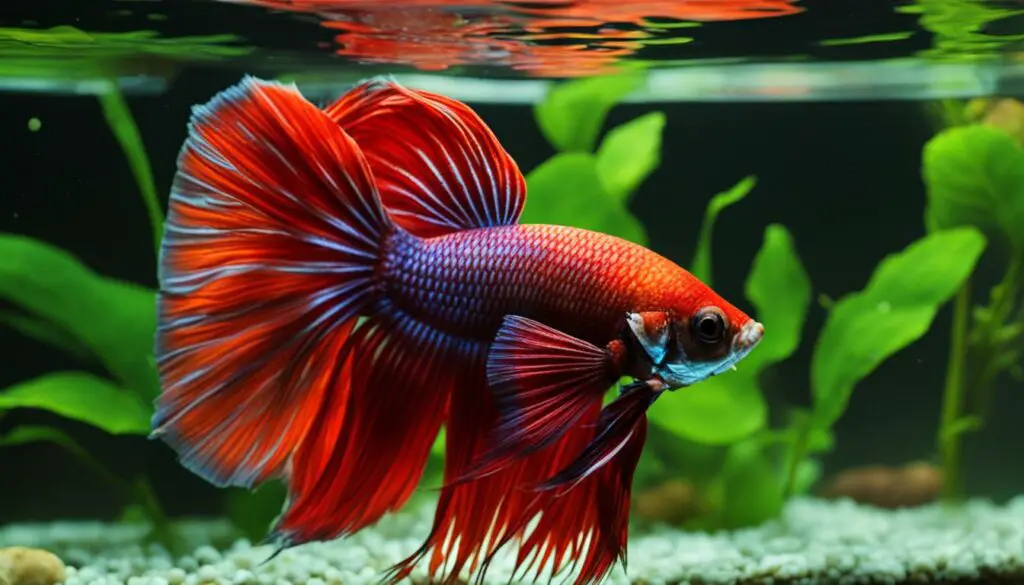
Seeking Veterinary Assistance for Swim Bladder Disease in Betta Fish
If you’ve tried adjusting your betta fish’s diet and environment but their swim bladder problems persist, it may be time to seek professional assistance. A veterinarian who specializes in fish health can diagnose the root cause of the issue and provide appropriate treatment.
During your visit, the vet may conduct a physical exam and request a water sample to check for any potential water quality issues. They may also prescribe medication to alleviate your betta fish’s discomfort and allow their swim bladder to heal properly.
What to Expect During a Veterinary Examination or Treatment?
During the examination, the vet may ask you questions about your betta fish’s diet, environment, and symptoms. They may also perform a visual inspection to check for any abnormalities or signs of infection.
If medication is prescribed, make sure to administer it as directed by the vet. Depending on the type of medication, it may need to be added to the water or given orally.
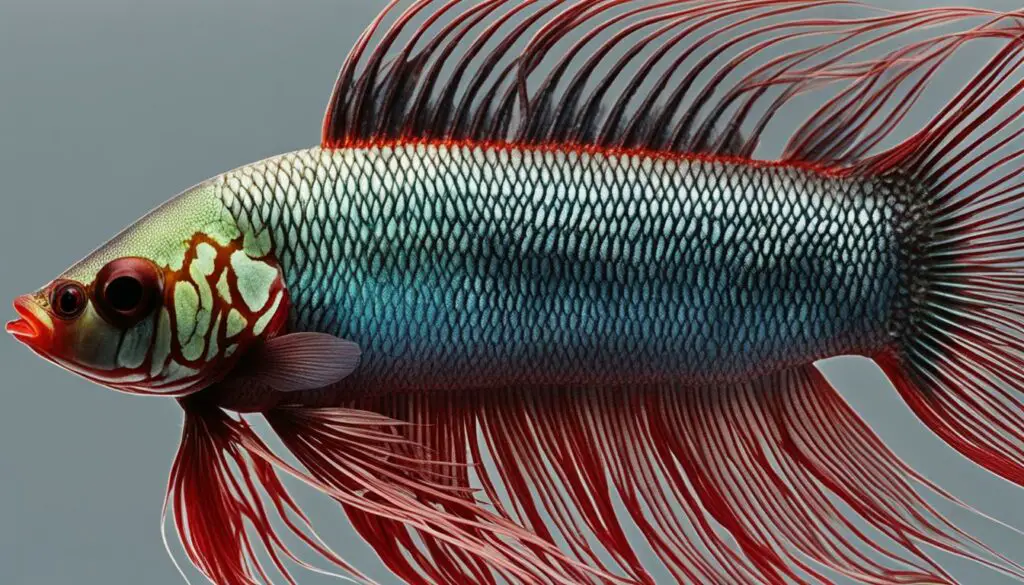
“It’s essential to seek veterinary assistance if your betta fish’s swim bladder problems don’t improve with dietary and environmental changes. A fish veterinarian can provide an accurate diagnosis and recommend the best course of action for your beloved pet.”
Remember, prevention is key when it comes to swim bladder disease in betta fish. By maintaining optimal water quality, feeding a balanced diet, and providing a stress-free environment, you can help reduce the risk of your betta fish developing swim bladder issues in the first place.
Preventing Swim Bladder Problems in Betta Fish
Betta fish are susceptible to swim bladder problems, but there are steps you can take to prevent this condition from occurring. By implementing the following practices, you can help keep your fish healthy and happy:
- Keep the tank clean and well-maintained to avoid any potential infections or illnesses. This includes regular water changes and monitoring the water parameters.
- Avoid overfeeding your betta fish, as excess food can lead to constipation and swim bladder problems. Follow a feeding schedule and only provide as much food as your fish can consume within a few minutes.
- Choose high-quality fish food that is specifically formulated for betta fish and provides all the necessary nutrients. Avoid feeding your fish foods that are high in filler ingredients, such as wheat and soy.
- Ensure that the tank is appropriately sized for your betta fish and has adequate filtration. Overcrowding and poor water circulation can cause stress and lead to swim bladder issues.
- Introduce new fish and plants to the tank slowly and carefully, as sudden changes can cause stress and increase the risk of swim bladder problems.
- Finally, monitor your fish closely for any signs of swim bladder disorder and seek veterinary assistance if necessary.
By following these preventative measures, you can help ensure that your betta fish remains healthy and happy for years to come.

Conclusion
In conclusion, treating swim bladder disease in betta fish requires patience and commitment. By following the guidelines provided in this comprehensive guide, you can effectively manage your fish’s swim bladder problems and prevent them from recurring.
Remember to monitor your betta fish closely for any signs or symptoms of swim bladder issues, maintain their water conditions, adjust their diet and feeding habits, and provide them with an appropriate tank setup. If necessary, seek professional veterinary assistance to ensure your fish receives the best possible care.
Thank you for choosing us as your guide on how to treat betta fish swim bladder!
FAQ
How do I treat swim bladder issues in betta fish?
Swim bladder issues in betta fish can be treated by adjusting their diet, maintaining optimal water conditions, and providing a suitable tank setup. Natural remedies and veterinary assistance may also be necessary in some cases.
What is swim bladder disease in betta fish?
Swim bladder disease is a common ailment that affects the swim bladder, a gas-filled organ that helps fish control their buoyancy. It can cause betta fish to have difficulty swimming and maintaining their balance.
How can I identify swim bladder problems in my betta fish?
Look out for signs such as floating or sinking issues, loss of appetite, and an abnormal posture. If your betta fish exhibits these symptoms, it’s important to take action and provide appropriate care.
How can I adjust my betta fish’s diet to manage swim bladder problems?
Feed your betta fish small, frequent meals of high-quality and easily digestible food. Avoid overfeeding and opt for pellets or flakes specifically formulated for betta fish.
How do I maintain optimal water conditions for my betta fish?
Regularly test and monitor the water parameters, such as temperature, pH, and ammonia levels. Perform water changes as needed and ensure the tank is properly filtered and aerated.
What should I consider when providing an appropriate tank setup for my betta fish?
Ensure the tank size is appropriate, provide hiding spots and plants for enrichment, and ensure proper filtration and aeration. Avoid overcrowding and maintain a stress-free environment.
Are there any natural remedies or treatment methods for swim bladder problems in betta fish?
Yes, there are natural remedies such as adding Epsom salt to the tank or using herbal remedies. However, it’s important to consult an expert or veterinarian before trying any alternative treatments.
When should I seek veterinary assistance for swim bladder issues?
If your betta fish’s swim bladder problems persist or worsen despite your efforts, it’s advisable to seek professional help. A veterinarian can provide a thorough examination and recommend appropriate treatment.
How can I prevent swim bladder problems in betta fish?
Prevent swim bladder problems by maintaining a clean and well-maintained tank, feeding a balanced diet, avoiding overfeeding, and minimizing stress factors such as sudden changes in water conditions or aggression from tankmates.

